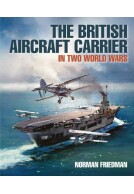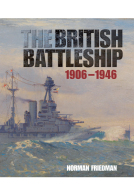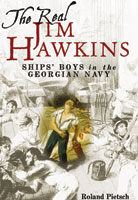Fighters over the Fleet (ePub)
Naval Air Defence from Biplanes to the Cold War

File Size: 22.5 MB (.epub)
Pages: 460
Illustrations: 400
ISBN: 9781848324060
Published: 28th November 2016
Book Of The Month
Chosen as the May 2017 Book of the Month for Aeroplane Monthly!
This is an account of the evolution of naval fighters for fleet air defence and the parallel evolution of the ships operating and controlling them, concentrating on the three main exponents of carrier warfare, the Royal Navy, the US Navy, and the Imperial Japanese Navy. It describes the earliest efforts from the 1920s but it was not until radar allowed the direction of fighters that organised air defence became possible. Thus major naval-air battles of the Second World War – like Midway, the ‘Pedestal’ convoy, the Philippine Sea and Okinawa – are portrayed as tests of the new technology. This was ultimately found wanting by the Kamikaze campaigns, which led to postwar moves towards computer control and new kinds of fighters.
After 1945 the novel threats of nuclear weapons and stand-off missiles compounded the difficulties of naval air defence and the second half of the book covers RN and USN attempts to solve these problems, looking at US experience in Vietnam and British operations in the Falklands War. It concludes with the ultimate US development of techniques and technology to fight the Outer Air Battle in the 1980s, which in turn point to the current state of carrier fighters and the supporting technology.
Based largely on documentary sources, some previously unused, this book will appeal to both the naval and aviation communities.
This is the definitive text on the subject, absolutely recommended to all scholars of this subject and whose contents largely compensate for the non-economic cost of the book.
STORIA militare, March 2019
The book contains hundreds of black and white pictures of planes and carriers in varying sizes. Most of them I had not seen before. The letter type in this book is a bit smaller than usual, but with my 46 year old eyes this still goes very fine! The book is anyhow a splendid book for on your book shelf in which you would like to read a bit left and right when there is a reason for it. It is more than excellently documented (45 pages with notes!). The only negative point which I could think of is that it doesn’t contain colour pictures. But that is abundantly made up with all the content and the hundreds of pictures, drawings and cross-sections of planes. It must have been an immense job to make this book! For every navy fan a must have! Complements, well done Norman! For me personally the book comes in my top 5 of best published aviation books.
Aviation Book Reviews
Read the full review here
This is a useful study of a key element of modern naval operations, providing a detailed and thoughtful account of the problems posed by aerial attacks, and the vast amount of effort that had gone into countering those threats over the years.
History of War, John Rickard
Read the complete review here.
This new work is both a technical and tactical history covering the dawn of naval aviation in the 1920s to the Falklands Islands War.
Military Heritage, September 2017 – reviewed by Christopher Miskimon
In this mammoth work, Norman Friedman has complemented his earlier volume Naval Anti-Aircraft Guns and Gunnery, covering fleet air defence in the pre-missile era, with the other main element of fleet air defence, the use of fighter aircraft flying from aircraft carriers. Starting with a review of the major carrier navies, the RN, USN and IJN, the book then proceeds to review the various fighters, both with and without radar guidance, the problems they encountered in the Kamikaze raids, the introduction of jet fighters to fleet defence with the 3 British inventions (angled deck, mirror landing sight and steam catapult) that made jet operations possible, lessons learned during the Korean War, the development of Soviet maritime air power during the Cold War, the introduction of computers into fleet air defence, the lessons of Vietnam and the Falklands, all leading to the US Maritime Strategy of the 1980s with its implicit need to destroy Soviet Naval Aviation and do so at sufficient distance that stand-off missiles could not engage their carrier battle groups.
Review by John Francis MA (Maritime History), Greenwich Maritime Institute, UK
It is important to remember that this book is about fleet air defence, not naval air strike attack, except where it needs to cover defence against such strikes by an enemy. Friedman is very careful not to stray from the task he set himself with this book.
Make no mistake about it, this book is not a light read. Rather it is an extremely detailed work based on Friedman’s wide knowledge of the topic, with over 30 earlier titles to his credit. Added to this is further extensive research in USN’s BuAir and UK’s National Archives covering the Admiralty papers. In places this background information is used to excess, particularly in the development of new concepts of jet aircraft where presentation of manufacturers’ design drawings and specification information in the script tends to disrupt from the story, especially with the lengthy comments that accompany the drawings. However the descriptions of the development of both ships and aircraft, particularly the political and manufacturing in-fighting, show a knowledge of the topic that few writers can match. And this is not just of US aspects, even though these do take preference, if only because of the numbers of aircraft and carriers in service within the USN. Certainly there was no match for these in the RN and although the IJN started WWII with comparable numbers, there was no way it could match US war-time production. Equally in the post WWII and Cold War era, there was no real direct competition, as none of its adversaries sought to compete directly. Yet Friedman does not lose sight of the way other nations produced their own solutions and, in an interesting Epilogue, mentions the development of Indian and Chinese carrier forces.
Overall this is an excellent work which demonstrates the author’s wide knowledge of all aspects of the topic and all nations’ approach to it. It may well become the standard reference book on the topic. It adds so much to our knowledge, particularly with information of what was previously secret or confidential on ways in which the USN could be attacked by lesser powers (and how it reacted) that the audience for this book may prove wider than usual.
A very useful volume for those interested both in the development of the fighter arm of the fleets and of the carriers themselves.
Ships in Scale, March/April 2017 - reviewed by Roger Marsh
In his introduction, Friedman acknowledges many sources. This work is clearly the result of much trawling through archive material, but he notes, worryingly, that the archives of aircraft companies are "a resource now largely shut to researchers".
Aeroplane Monthly, May 2017
The text covers far more than just the ships, aircraft and weapons, and delves deeper into the requirements, the technologies, the politics and the development programmes behind them. Despite this level of detail, his account remains readable, and is peppered with fascinating insights.
Rating: 5 stars - outstanding
The author provides a very compelling argument, well reinforced with primary sources. It is highly recommended for anyone with an interest in naval aviation, and is a superb reference.
The Aviation Historian, issue no 19 – reviewed by Matthew Willis
It is highly recommended for anyone with an interest in the development of modern navies and their aircraft.
Warship World, March-April 2017
... the handsome 460-page volume is a mine of information and highly intelligent and perspective policy and technical analysis. It is beautifully produced and illustrated and is essential reading for all interested in 20th Century naval warfare.
Navy News, April 2017 - reviewed by Eric Grove
This book is probably the most comprehensive study of naval aviation and the importance of the fighter to provide defence
Firetrench
to a fleet. The author has produced extensive notes, bibliography, data and index to help the reader find a way through the considerable
amount of detail on naval aviation from the major navies - Most Recommended
Read the full review here.
In the opinion of this reviewer, this volume is likely to have wide appeal and could be of interest to both Naval and Aviation historians and to hobbyists with an interest in ‘matters naval’ in general, naval fighter aircraft, aircraft carriers and aerial combat. Those with a specific interest in United States Navy tactics and aircraft carrier operations are especially fortunate in this regard. In addition, by providing a ‘naval’ perspective on political events, those with an interest in international affairs (such as the ‘Korean War’) could also find it worth perusing.
NZ Crown Mines
As previously-noted, this volume bids fair to become an authoritative work on its subject; ‘Naval Fighters’ although it does have its flaws. Despite these, and on a Rating Scale 1: Very Poor, 10: Excellent, I have given it a 9.
This comprehensive account is a description of the evolution of naval fighters for fleet air defence and the parallel evolution of the ships operating and controlling them. It focuses on the Royal Navy, the US Navy and the Imperial Japanese Navy, offering a wealth of insight and detail, taking in technology, strategy and operations. Describing tactics that emerged in the 1920s all the way up to the modern era, it is also lavishly illustrated and very well managed by author Norman Friedman, one of America's best known naval analysts and historians.
Fly Past, March 2017
The profuse illustrations throughout the volume are well-chosen and supported by captions that often amount to small essays in their own right. The volume concludes with a tabular comparison of all the operational aircraft mentioned within.
Society of the Fleet Air Arm Museum
About Norman Friedman
NORMAN FRIEDMAN is arguably America’s most prominent naval analyst, and the author of more than thirty books covering a range of naval subjects, from warship histories to contemporary defence issues. His most recent titles in a series of successful works for Seaforth are the two volumes of his history of British Submarines.





















